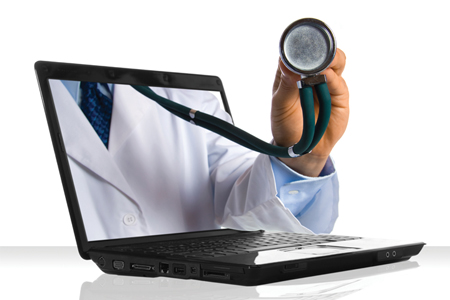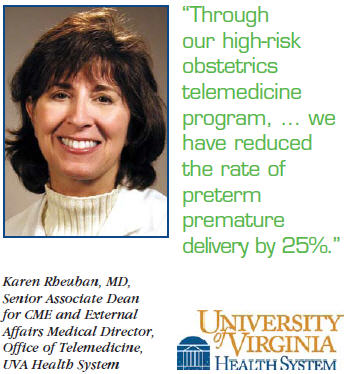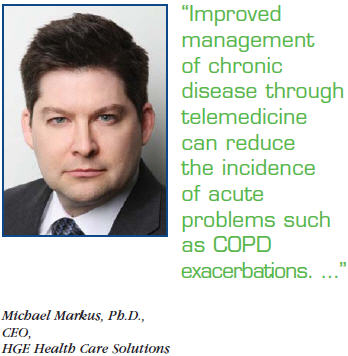Can Telehealth Become Mainstream Medicine?
Compiled by Cindy Dubin, Contributing Editor
As the healthcare industry moves toward adopting more technology, telehealth programs are popping up around the country. Two healthcare facilities explain how their telehealth systems keep patients connected and improve care quality.


Fueled by healthcare reform aimed at reducing inpatient costs and post-acute care strategies designed to reduce readmissions, the worldwide telehealth (remote patient monitoring) market will grow by 55% in 2013 in device and service revenues, according to a recent report from InMedica. Such growth is significantly higher than the telehealth growth rates seen in recent years.
Telehealth is the use of electronic information and telecommunications technologies to support long-distance clinical healthcare, patient and professional healthrelated education, public health, and health administration. Technologies include videoconferencing over the Internet, store-and-forward imaging, streaming media, and terrestrial and wireless communications.
In this industry roundtable, executives from two healthcare facilities – UVA Health System and HGE Health Care Solutions — share their experiences about telehealth technology and the benefits it has brought to their organizations and their patients.
Q: How are you taking advantage of telehealth technology at your company?
Dr. Markus: HGE is a spin-off of Temple University focused on developing solutions related to chronic disease management. During the last 10 to 15 years, many faculty members have investigated telemedicine as a promising venue for remotely managing patients with chronic disease like heart failure, diabetes, and COPD.
HGE was formed to bring a particular solution, developed and studied by Dr. Gerard Criner at Temple Health’s Lung Center, to market. We are using mobile applications to remotely monitor post-discharge COPD patients and provide real-time communication with their primary care providers.
Because Temple is a safety net hospital dealing primarily with Medicare, Medicaid, or uninsured patients, providing care to Temple’s patients, unfortunately, creates a significant financial burden to the institution. There is a strong incentive — here and elsewhere — to provide high quality care at a fraction of the current cost. For example, there are 14 million patients in the U.S. diagnosed with chronic COPD. In 2010, the cost to treat that population was $50 billion. Two-thirds of the cost was associated with acute COPD exacerbation, which occurs when a patient has a spike in symptoms, can’t breathe, goes to the emergency room, and spends one or more days in the hospital. Improved management of chronic disease through telemedicine can reduce the incidence of acute problems such as COPD exacerbations, thereby improving the quality of life for the patient and reducing the financial burden to the institution.
Dr. Rheuban: The University of Virginia Health System recognized that it was impossible to have a physical presence 24 hours a day, seven days a week in many of our surrounding communities. This realization led to the establishment of our telemedicine program in the 1990s. We built our program to support all the clinical service lines and are currently connected to 94 sites in Virginia. Our services range from prenatal to end-of-life care, from acute care services to chronic disease management. Telemedicine is a very important element of our institutional outreach efforts.
Q: What technology makes up your telehealth program?
Dr. Markus: While Temple Health has many different telemedicine solutions offered across various departments, HGE is focused initially on bringing to market its COPD solution. Patients utilize a mobile application to participate in a daily electronic “check-in.” The information provided during the “check-ins,” along with rigorously tested algorithms, determines whether a patient’s current symptoms are typical for that patient or are indicative of a potentially impending acute exacerbation. In the case of the latter, a critical management team is notified immediately so it may intervene appropriately. The intervention typically takes place remotely, and the patient may have to visit the hospital only in extreme circumstances.
Dr. Rheuban: The goal of our program is to augment what is not locally available in our partner communities. Thus, the services we offer and the technologies we select are tailored to the individual community needs. For example, in several community hospital settings, there is no pediatric cardiologist. In those hospitals, we offer 24/7 pediatric cardiac ultrasound support for their newborn intensive care unit, using store-and-forward technologies. Other store-and-forward services we offer include teleophthalmology to support screening for diabetic retinopathy. In many communities, we offer high-definition, live video-conferenced clinical consultations and followup visits using broadband communications. Examples of these services might include videoconferencing for telemental health services, teledermatology, or high-risk obstetric care in partnership with health department clinics or federally qualified health centers. We also have a successful telestroke program, which allows a patient suffering from an acute ischemic stroke to be evaluated by our stroke neurologists. When coupled with the transfer of CT scans, such evaluation facilitates the local administration of clot dissolving agents that can greatly reduce morbidity and mortality of a stroke. All patient services are integrated into our EPIC EHR.

Q: What roadblocks did you experience in getting these telehealth solutions deployed?
Dr. Markus: One challenge has been deploying the technology to a large patient population. For instance, only about 30% of our patient population has a smartphone, which is the primary delivery vehicle we’d like to use. While they can use the Web to enter their information, that’s not the way we’d like to go to market with the app for optimal use.
An additional challenge is how providers or patients are reimbursed for the app. Medical devices are typically reimbursed by third-party payers. Again, this is a relatively young market, so third-party reimbursement and coverage are not as well-established as for other medical devices.

Dr. Rheuban: At the inception of our program, it seemed that everything was a challenge: high costs of communications services, high cost of equipment, technologies that were not interoperable, nonreimbursement by payers, provider and patient skepticism of the service, etc. However, following passage of the Telecommunications Act of 1996, with the provision for the rural healthcare program of the universal service fund, we were able to avail ourselves of deeply discounted telecommunications services.
A favorable reimbursement climate has been incredibly important to the development, expansion, and sustainability of our telehealth program. When we launched in 1996, there was essentially no reimbursement for telemedicine. However, we have come a long way, despite not yet being entirely mainstream healthcare. Medicare has improved its reimbursement for telemedicine services, although the Center for Medicare and Medicaid Services (CMS) still only reimburses for “rural” patients, and the definition of rural is pretty prescriptive. Some of the payers have embraced telemedicine, but in general it has taken state intervention to advance telehealth for non-Medicare, nonveteran beneficiaries.
Q: What are the benefits of telehealth to your organization and your patients?
Dr. Markus: Based on a six-year pilot study of the app at Temple Health, Dr. Criner reduced moderate and severe exacerbation in COPD patients by 35%, and lung function improved just by keeping them better connected to their physicians.
Dr. Rheuban: Through our high-risk obstetrics telemedicine program, which connects our obstetricians to providers and underserved patients, we have reduced the rate of preterm premature delivery by 25%. That represents a huge benefit to families, to the infants themselves, and even to our state Medicaid program, which bears a significant financial burden of preterm delivery, not to mention the potential lifetime of hardship that can come from extreme preterm delivery.
The same is true for the delivery of stroke services. In the community hospital settings in which we have established telestroke programs, we’ve effected a significant increase in the appropriate use of clot dissolving agents (TPA), particularly, in a community in which those drugs were not previously administered because of concern for complications. When supervised by a stroke neurologist, stroke patients have demonstrated an increase in TPA use from zero to 16%.
Q: What best practices would you recommend to others looking to adopt telehealth?
Dr. Markus: First, understand the demographic population you’re dealing with. Second, know what costs and clinical outcomes can be achieved. Finally, patients will demand connectivity to their healthcare providers, and those entities that can provide that capability will be most successful.
Dr. Rheuban: You don’t have to reinvent the wheel. The federal government has designated telehealth resource centers, and there are resource centers that cover every state in the U.S. through funding from HRSA (Health Resources & Services Administration). Establishing a telehealth program just requires a bit of creativity to determine what service is best provided over telemedicine. Creatively look at opportunities to improve health using broadband communications.
